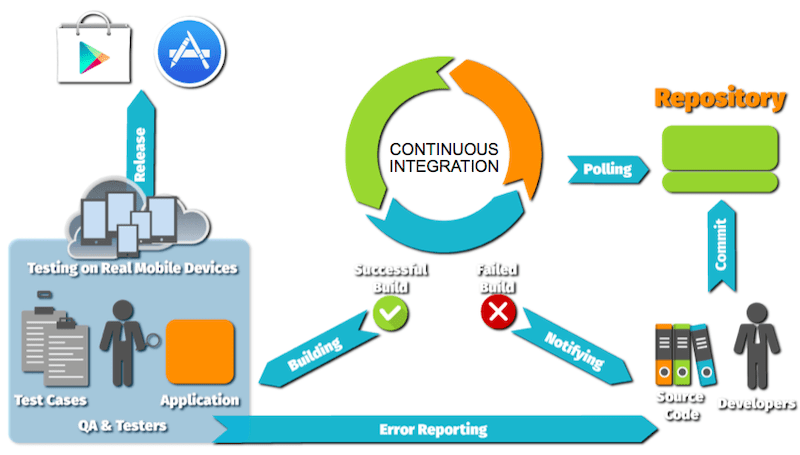What does Continuous Integration mean?
Continuous Integration (CI) is a process where developers regularly, usually many times a day, insert code into a public repository. Automated design and automated testing will then validate through integration.
It is a process in which any engineering team leader combines the work of others on an on-going basis with the work of others. Differences in the computer technique and duplicated commitment have been generated over such long periods, numerous disputes and difficulties (Techopedia, 2012).
What are the Continuous Integration requirements?
Continuous Integration (CI) is a programming method where developers are required to add code many times a day in a public repository. Every check-in is then immediately reviewed and teams may diagnose issues promptly.
What is the key purpose of CI?
The goal of Continuous Integration is to provide fast input such that a fault can be detected and repaired as soon as possible before it is introduced into the codebase. To simplify monitoring and create a paper record, quality management tools may be used.
What has been the history of CI?
According to Circleci, continuous integration is not a modern concept and while it precedes what is regarded as agile methods, it was only in the year 2000 that the method was properly described. In his 1991 procedure, Grady Booch first suggested the word CI, but he did not consider incorporating many times a day.
The design used for Windows.NET 3.0 in the 1990s by Microsoft was proposed by Steve McConnell in the late 90s. This procedure was dubbed the approach and based primarily on integration frequency rather than automation.
Continuous integration was formally transformed as one of Extreme Programming’s (XP) central activities in 1998 — a methodology for software engineering that relies first on market results and adopts a continual evaluation and update methodology to product growth.
In 2000, Martin Fowler wrote an essay describing the method of “continuous integration.” And, in 2001 the first ‘continuous integration system’, was released under an open-source license. It was named as CruiseControl.
What are the Principles of Continuous Integration?
The principles of the CI include a list of versions, process automation, the design auto-test rendering, baseline dedication, quick construction, development process clone checking, the new supply, and the new construct effects (Forbes, 2018).
How does the integration work?
· Developers input code in their private computers;
· They add mutual registry updates after everything has been completed;
· The CI service tracks and analyzes the modifications in the repository as they happen;
· The device is continually implemented and unit and installation checks are carried out;
· The repository also publishes objects for research that can be deployed;
· A variant of the application it just created is given a development tag by the server CI;
· The project reviews of a productive construct are given on Continuous Integration site;
· The application notifies the production team when constructing or checking fails;
· The department must tackle the challenges as easily as necessary; and
· The whole scheme needs to be implemented and research performed.
Importance of Continuous Integration in Business
At present, several world’s top design firms employ continuous integration and various continuous systems. Although it may be challenging for smaller engineering teams to devise a broad continuous integration process, it is always the same result to execute one, quicker implementation with fewer errors.
CI, a Continuous Source Integration (CD) mechanism which is dedicated to technology and continually produces it continuously, supports both IT departments and their stakeholders. With CI, the app development process is being speeded up and streamlined by creating continuous integration (CI).
Advantages of continuous integration
Quality– Through automated testing, by the end of the production, a produced component of software has substantially fewer glitches. The concepts of continuous improvement encourage the team to collaborate in a process. In such a way, members try a remedy at their level in the event of any issue.
Speed– By performing on-going checks, it can easily detect glitches. In a few seconds, developers can get a notification and quickly work on fixing these errors. The regression tests which take a minimum of time after the project is complete can also be performed along with CI for better results.
Cost– This cost better because defending requires a better time. Ask them how to check apps while you are searching for a business to recruit. This takes hours for you to check your product and identify and correct the glitches, though you also pay for this because they focus mostly on manual testing and do not use automated testing.
How to make the most of the Continuous Integration?
Begin your path but make sure you don’t fall with the wrong decision. Don’t spend time arguing if your CDs are correct or whether continuous delivery is appropriate. The time has come to know. If you are still nervous, and your company eventually runs dry, you can only blame yourself. This isn’t everything you have to do with this journey. The idea that you are on this path opens up doors for the squad to develop continuously! It can stretch your horizons by encouraging you to innovate fearlessly.
So, if you are interested in your workers that do not blow up because of the drops of “midnight oil,” and others that get to work and develop their own lives rather than help a house that is continually falling apart, then the importance is apparent. Can you please consider this?
The Future of Continuous Integration
Over the last ten years, continued incorporation (CI) has been one of the core foundations of the trend towards agile product growth. The future seems better yet. CI continues to progress at a rapid rate. Due to emerging development infrastructure and the corresponding version control mechanisms, the quality of updates and overall project reliability is dramatically increasing. Teams are required to adjust to the production methods and resources to make the best of the pattern that the software technology industry has developed in the last 15 years.




